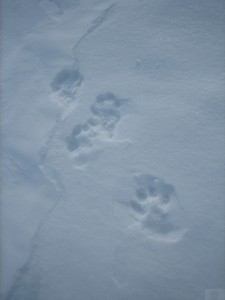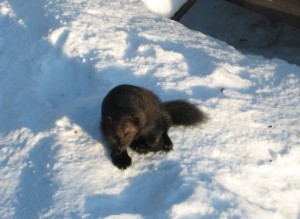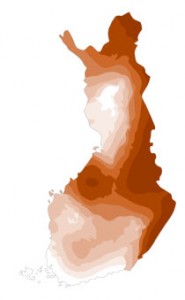A Government decree on the payment of compensation for damage caused by carnivores came into force in Finland in 2000, stating that payments should be made from budgeted government funds for damage caused by bears, wolves, lynxes or wolverines to people, traffic, farmland, livestock, reindeer, pets or property. Last year, in 2013, the amount of damage compensation for damages caused by carnivores in Finland was about 8,5 million euro. 94 % of the damages was made by wolverines. There has been a huge increase in the last years.
The Finnish Forest and Park Service (Metsähallitus) explains why it is important for nature to have these carnivores on the page telling about the Finnish carnivores:
“Large carnivores are a valuable and integral part of the natural environment in Finland. In ecological terms, large carnivores play a vital regulatory role maintaining the natural balance in ecosystems. Large carnivores have evolved to keep the populations of larger herbivorous mammals in check. They also generally tend to prey on weaker individuals, thereby improving the genetic stock of their prey species through the processes of natural selection.”
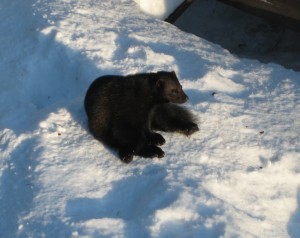 I use to visit the Ranua zoo regularly because I am fascinated by the sight of these animals. In Ranua zoo they have individuals representing all these four carnivores. My dilemma is that I am also very found of reindeer, and the fact that reindeer often become victims to all these carnivores is just breaking my heart. It is hard to understand why a little animal like the wolverine has to kill a big reindeer to get food, as it does not even eat it up but leaves the carcass after having a bite; preferably the heart of the reindeer. The wolverine jumps up on the back of the reindeer and with a bite in the neck it kills or at least paralyses the reindeer. A small animal could, in my opinion, survive eating smaller species from the Lapland nature like lemmings and sorks. Sometimes they do store their pray and return to eat from the same carcass.
I use to visit the Ranua zoo regularly because I am fascinated by the sight of these animals. In Ranua zoo they have individuals representing all these four carnivores. My dilemma is that I am also very found of reindeer, and the fact that reindeer often become victims to all these carnivores is just breaking my heart. It is hard to understand why a little animal like the wolverine has to kill a big reindeer to get food, as it does not even eat it up but leaves the carcass after having a bite; preferably the heart of the reindeer. The wolverine jumps up on the back of the reindeer and with a bite in the neck it kills or at least paralyses the reindeer. A small animal could, in my opinion, survive eating smaller species from the Lapland nature like lemmings and sorks. Sometimes they do store their pray and return to eat from the same carcass.
Reindeer are easy prey for the wolverine to kill (in winter the wolverine mainly lives on reindeer), to tear up into pieces and hide for a “rainy day”. The wolverine does not sink into soft snow nearly as much as a reindeer does. The weight of a reindeer per cm² of its base is 8 – 10 times that of a wolverine. The wolverine does not always kill reindeer for food, but does it for “fun”, too. To read more about reindeer herding and predators, visit the site of the Reindeer Herders’ Association.
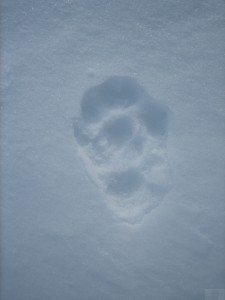 In the wilderness of Lapland I have once seen a wolverine (Gulo gulo). It looked so small and neat to my eyes. We were out icefishing in the Upper North of Finland and suddenly it appeared on the ice of the river. Even if it is said they have an excellent sense of smell, it did not recognize us and we followed its movements from a distance of approx 75-100 meters for quite a long time until it disappeared again behind some fell birches. After that I walked to the place where the wolverine had left some footprints. This was a very small wolverine, perhaps only a young wolverine or a female. The male wolverine grows to approx. 28 kg and the female to approx 12 kg. The length varies from 69 to 83 cm.
In the wilderness of Lapland I have once seen a wolverine (Gulo gulo). It looked so small and neat to my eyes. We were out icefishing in the Upper North of Finland and suddenly it appeared on the ice of the river. Even if it is said they have an excellent sense of smell, it did not recognize us and we followed its movements from a distance of approx 75-100 meters for quite a long time until it disappeared again behind some fell birches. After that I walked to the place where the wolverine had left some footprints. This was a very small wolverine, perhaps only a young wolverine or a female. The male wolverine grows to approx. 28 kg and the female to approx 12 kg. The length varies from 69 to 83 cm.
Wolverines’ fur is generally dark brown, but some individuals are paler brown or blackish. Their tracks are surprisingly large, and resemble the footprints of a small bear. Their large paws enable them to move around in the snow easily without sinking into drifts. Wolverines most commonly move in leaps and bounds, leaving their tracks in pairs or groups of three.
However, the population of wolverines in regions where reindeer are raised has increased from 40 specimen in 1980 to 180 in 2010, and the Government has to take into consideration giving permissions to the Lappish people to hunt the wolverine again. It is a protected specimen and hunting is not allowed at the moment.

